
Screening tests are the tools doctors use to look for signs of breast cancer before symptoms appear. These tests are the most effective way to improve early detection, which in turn reduces the risk of breast cancer mortality.
Breast cancer is one of the most common cancers among women worldwide, affecting millions each year. It’s also the second leading cause of cancer death among women in the US.
However, don’t despair!
Regular breast cancer screening – following official breast cancer screening guidelines – can help catch it when it’s most treatable. And although breast cancer outcomes can differ by ethnicity, with newer treatments available you’re more likely to survive.
There are several screening tests for breast cancer, ranging from mammograms to physical exams. Each plays a role in improving breast cancer detection, but mammography is usually the first screening for breast cancer in most women. To make it easier to attend your appointment, follow our checklist here.
If you’re searching locally for a “mammogram Dallas” option or “breast screening near me,” we’ll help you understand your choices so you can arrange a breast cancer risk assessment with your doctor.
Table of contents
What are Screening Tests for Breast Cancer?
What are the Three Main Imaging Tests for Breast Cancer?
Mammography: The Primary Screening Test for Breast Cancer
Breast Ultrasound: An Alternative or Complement to Mammograms
Breast MRI: Advanced Imaging for High-Risk Women
New and Emerging Breast Cancer Screening Tests
Tests for Breast Cancer Beyond Mammograms
What are the Warning Signs That May Require Additional Testing?
 What are Screening Tests for Breast Cancer?
What are Screening Tests for Breast Cancer?
Screening tests for breast cancer are medical exams designed to detect breast cancer before you have symptoms. They can find abnormalities at an early stage, when treatment is more effective and survival rates are higher.
There are three main categories of screening tests:
Imaging tests such as mammography, breast ultrasound, and breast MRI.
Physical exams, including a clinical breast exam performed by a healthcare professional.
Lab tests, which may support a breast cancer diagnosis or monitor treatment but are not commonly used as the first step.
Among these, screening mammography is recommended the most widely.
It’s the main method of breast cancer screening worldwide and recommended in most breast cancer screening guidelines.
Whether you’re following general advice or considering your personal risk factors of breast cancer, we advise you to start regular cancer screening to protect your long-term health and reduce the risk of breast cancer taking you by surprise.
For many women, that begins with screening for breast cancer through routine mammograms.
What are the Three Main Imaging Tests for Breast Cancer?
The three most common breast cancer screening tests are the mammogram, breast ultrasound, and breast MRI.
Each test plays a different role in cancer screening, depending on your age, medical history, and risk for breast cancer.
Mammogram: The first-line choice in most breast cancer screening programs. It uses very low-dose X-rays to reveal suspicious changes in your breast tissue, including very small tumors.
Breast ultrasound: Often used alongside a mammogram, ultrasound is helpful for distinguishing between solid lumps and fluid-filled cysts. It’s especially valuable if you have dense breast tissue.
Breast MRI: Recommended mainly for women at high risk, magnetic resonance imaging (MRI) provides detailed images that can highlight areas that mammograms or ultrasounds miss.
Together, these three screening tests form the basis for modern breast cancer screening guidelines.
How do you choose the right one to avoid risk of breast cancer? This depends on your personal history, your physician’s advice, and your individual breast cancer risk.
 Mammography: The Primary Screening Test for Breast Cancer
Mammography: The Primary Screening Test for Breast Cancer
A mammogram breast cancer screening is still the most effective tool to achieve a timely breast cancer diagnosis.
This imaging test uses low-dose X-rays to capture detailed images of your breast tissue. Your doctor can then identify tumors too small to be felt during a physical exam.
Most experts recommend annual screening mammography beginning at age 40, although the US Preventive Services Task Force advises mammograms every two years between ages 40 and 74. Your doctor can help you decide what’s best for you.
For women at high risk, such as those with a strong family history or known genetic mutations, annual screening may begin earlier.
These recommendations align with most leading breast cancer screening guidelines designed to reduce breast cancer mortality through earlier intervention.
Doctors may also suggest mammography screening more frequently if you have dense or abnormal breast tissue.
Are you worried about the risks of over-testing?
Worried about so many screenings? We understand. Yes, you may hear about the risks of over-testing or false positives leading to tests or treatments you didn’t need. But if you follow your physician’s breast cancer screening recommendations for you, you’ll benefit from the best balance between testing and risks.
What are the Different Types of Mammograms?
There are three main types of screening mammography available today:
Traditional (2D) mammography
This older method captures two flat X-ray images of each breast. Many clinics still use it, but it’s gradually being replaced by newer technology.
Digital mammography
This is a more advanced approach where the images are stored electronically. Digital files allow radiologists to zoom in, adjust contrast, and share results more easily. This improves breast cancer screening accuracy.
3D mammography (tomosynthesis)
This technique takes multiple images from different angles, creating a layered view of breast tissue. It’s particularly helpful for women with dense breast tissue, because overlapping structures can make it harder to spot small tumors with 2D images.
Doctors choose the most appropriate type of mammography screening based on your age, medical history, and whether you have risk factors of breast cancer.
If you search for “breast screening near me” you can now find many facilities offering 3D mammography because it provides clearer results with fewer call-backs.
In every form, screening tests like mammograms are a proven way to support early detection and reduce breast cancer mortality.
 Breast Ultrasound: An Alternative or Complement to Mammograms
Breast Ultrasound: An Alternative or Complement to Mammograms
A breast ultrasound is an imaging test that uses sound waves to create pictures of the inside of your breast. It’s not a replacement for a mammogram, but it can be an important complement in breast cancer screening.
Doctors often recommend ultrasound when a mammogram shows something unclear, or if you have very dense breast tissue where X-rays may be less effective.
Unlike mammography, ultrasound doesn’t use radiation, so it’s a safe option during pregnancy.
How do mammograms and ultrasounds compare?
If we compare having a mammogram vs. an ultrasound, mammograms are generally better at finding very small calcifications.
Ultrasounds are more effective at identifying fluid-filled cysts or benign lumps in breast tissue. This makes it especially useful for ruling out non-cancerous conditions and reducing unnecessary biopsies.
Because ultrasound can’t always pick up the earliest tumors, it’s best to use it alongside screening mammography rather than as a stand-alone test.
In combination, however, these screening tests provide a fuller picture and increase the chances of detecting breast cancer at an early stage.
 Breast MRI: Advanced Imaging for High-Risk Women
Breast MRI: Advanced Imaging for High-Risk Women
A breast MRI is one of the most detailed forms of breast imaging available.
Unlike a mammogram or ultrasound, MRI uses powerful magnets and contrast dye to capture highly detailed pictures of your breast tissue. Because of its sensitivity, it can find tumors that other tests sometimes miss.
Doctors don’t recommend MRI for every woman.
Instead, they usually reserve it for women at high risk – for example, those with a strong family history of breast cancer, or known genetic changes like BRCA1 or BRCA2.
In these cases, a breast cancer risk assessment may help your doctor decide if MRI should be part of your regular cancer screening plan.
The advantages of MRI include detecting smaller tumors and improving early detection if you’re both high-risk and have dense breast tissue.
But there are drawbacks too: The test is more expensive, takes longer, and can sometimes lead to false positives that require extra follow-up, a risk we mentioned earlier.
If you’re unsure whether an MRI is right for you, talk with your breast cancer doctor. Together, you can weigh your personal breast cancer risk against the benefits and downsides of this advanced test.
 New and Emerging Breast Cancer Screening Tests
New and Emerging Breast Cancer Screening Tests
In addition to standard mammograms, researchers are developing new screening tests that may improve breast cancer screening in the future. These technologies are especially promising if you have dense breast tissue or a higher-than-average risk for breast cancer.
Contrast enhanced mammography
This contrast enhanced mammography test combines a standard mammogram with a special dye that highlights areas of abnormal breast tissue. It can improve accuracy when something suspicious shows up on an X-ray.
Molecular breast imaging (MBI)
This technique uses a small amount of radioactive tracer to highlight cancerous cells. MBI may help detect breast cancer that traditional imaging misses, though availability is still limited.
Automated breast ultrasounds (ABUS)
These tests scan your entire breast with automated equipment, again making them more efficient for women with dense breast tissue than traditional ultrasound alone.
Because many of these options are still being evaluated, they’re not yet included in standard breast cancer screening recommendations.
Still, they highlight the rapid progress in cancer screening and the possibility of more personalized approaches in the years ahead.
 Tests for Breast Cancer Beyond Mammograms
Tests for Breast Cancer Beyond Mammograms
While mammograms remain the primary method of breast cancer screening, there are other ways to check your breast health. These methods do not always count as primary cancer screening, but they can provide important information if something unusual shows up.
Clinical breast exam – During this exam, your healthcare provider uses their hands to feel for lumps or changes. A clinical breast exam is often part of a routine physical, and while it’s not as sensitive as imaging, it can still play a role in finding issues early.
Self-breast exam – Once widely promoted, self-exams are no longer a primary screening test. Still, knowing what’s normal for your body means you’re more likely to notice changes and talk to your doctor promptly. See below for what to look out for.
Blood tests – Not used for screening for breast cancer, but sometimes ordered to monitor treatment or detect recurrence.
Biopsies – If an imaging test finds something suspicious, a biopsy is the only way to diagnose breast cancer with certainty. That’s why there’s discussion in medical circles about balancing screening with the risk of false positives.
Depending on your age, health history, and personal breast cancer risk, your doctor may recommend one or more of these approaches alongside imaging.
If you’re uncertain, a trusted breast cancer doctor can help you decide which steps are best for you.
 What are the Warning Signs That May Require Additional Testing?
What are the Warning Signs That May Require Additional Testing?
We said we’d return to the topic of self-breast exam. So…
Even if you keep up with regular screening mammograms, it’s important to know the warning signs that could point to developing breast cancer between visits. If you notice any of the following changes, contact your healthcare provider promptly for additional evaluation:
- A lump or thickening in your breast or underarm
- A change in breast size, shape, or symmetry
- Nipple discharge, especially if it’s bloody
- Skin dimpling, redness, or scaling on the breast
- Persistent breast pain that doesn’t improve with time
These changes don’t always mean cancer, but they’re signals that deserve medical attention. Acting quickly helps reduce your risk for breast cancer progressing to a serious stage before it’s found on screening mammograms.
Doctors may recommend further mammography screening, a breast ultrasound, or even a breast MRI if something unusual appears.
If you see these warning signs, ask for a breast cancer screening outside of your regular schedule. Please don’t hesitate to call us. We’d rather you stay safe.
Taking Control of Your Breast Health
Your health is too important to leave to chance. Following recommended breast cancer screening schedules is one of the most powerful steps you can take to protect yourself.
These tests save lives by finding cancer earlier, when treatment is most effective and the chance of lowering breast cancer mortality is highest.
Remember, cancer screening isn’t one-size-fits-all! Your personal history, age, and risk for breast cancer shape which tests are right for you. For some, that means regular screening mammography. For others, it may include additional imaging or closer follow-up if you’re among the women at high risk.
The most important thing is staying informed. If you’re unsure about your options, come in and talk with one of our trusted breast cancer doctors in Dallas who can guide you through the latest breast cancer screening recommendations.
When you prioritize your regular annual screening, you’re supporting your lifetime wellness goals!
 Stella Mattina Can Help You with Screening Tests for Breast Cancer in Dallas
Stella Mattina Can Help You with Screening Tests for Breast Cancer in Dallas
All our doctors can help you understand which screening regime is best for your unique health history and risk – and arrange tests for you. And remember, most insurance plans cover screening mammography for eligible women. Don’t wait to safeguard your health!
Book today at a location near you.

Dr. Gonzalo Venegas
Gonzalo Venegas, MD is the Medical Director of Stella Mattina Health and a respected obstetrician-gynecologist with over four decades of service in the Dallas medical community. He has led the Department of Obstetrics and Gynecology at Methodist Dallas Medical Center and contributed to community health through his role on the Parkland Health & Hospital System Board. A dedicated mentor at UT Southwestern, Dr. Venegas is known for his leadership, compassion, and commitment to advancing women’s health and medical education.
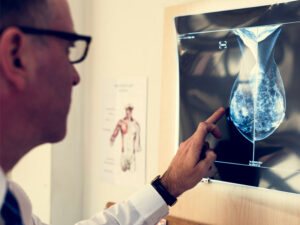 What are Screening Tests for Breast Cancer?
What are Screening Tests for Breast Cancer?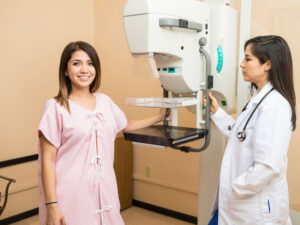 Mammography: The Primary Screening Test for Breast Cancer
Mammography: The Primary Screening Test for Breast Cancer Breast Ultrasound: An Alternative or Complement to Mammograms
Breast Ultrasound: An Alternative or Complement to Mammograms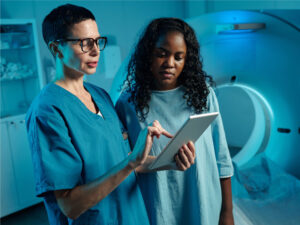 Breast MRI: Advanced Imaging for High-Risk Women
Breast MRI: Advanced Imaging for High-Risk Women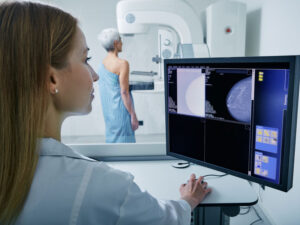 New and Emerging Breast Cancer Screening Tests
New and Emerging Breast Cancer Screening Tests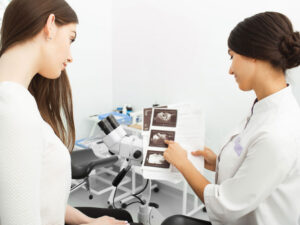 Tests for Breast Cancer Beyond Mammograms
Tests for Breast Cancer Beyond Mammograms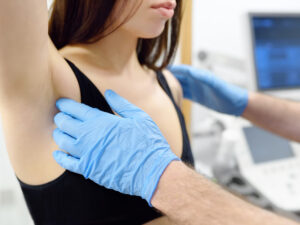 What are the Warning Signs That May Require Additional Testing?
What are the Warning Signs That May Require Additional Testing?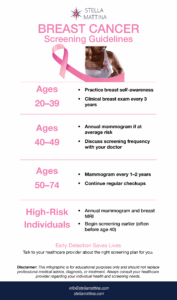 Stella Mattina Can Help You with Screening Tests for Breast Cancer in Dallas
Stella Mattina Can Help You with Screening Tests for Breast Cancer in Dallas